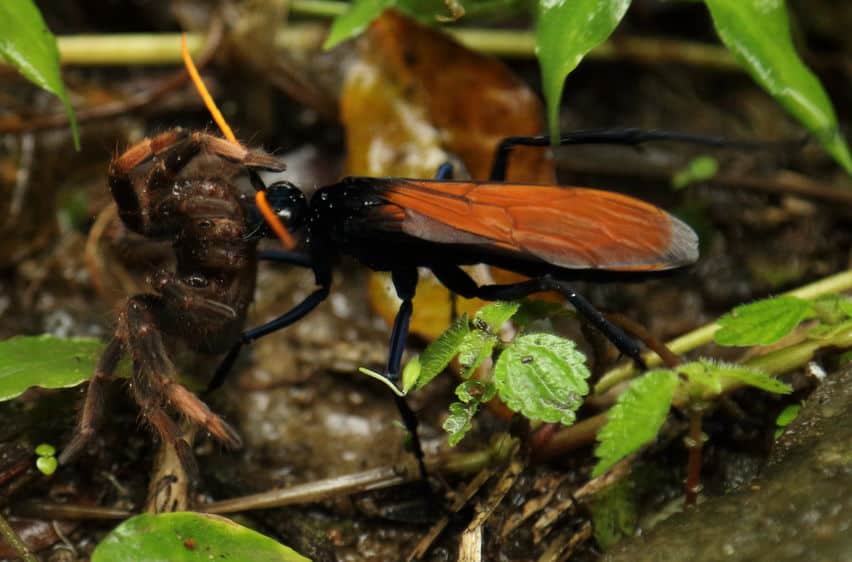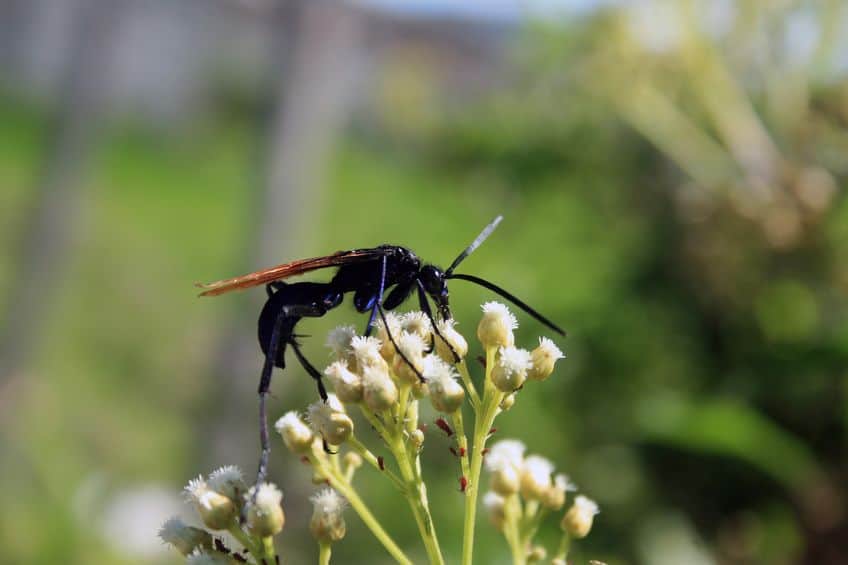Tarantula hawks, Pepsis, are spider wasps that prey on tarantulas. They are found in the southern United States and globally. Voted by school children the tarantula hawk was selected as the official insect of New Mexico in 1989. New Mexico provides the perfect desert environment for the tarantula hawk
Is the tarantula hawk sting painful?
They have one of the most painful stings among all insects. Entomologist Justin Schmidt, also known as the man of 1000 stings, ranked them at the top of his insect sting pain index. He described the sting as ‘Blinding, fierce, shockingly electric. A running hair dryer has just been dropped into your bubble bath.’ Read more.
What do tarantula hawks prey on?
They specialize in preying on spiders, specifically tarantulas, that they expertly paralyze and deliver as food for their young. Tarantula hawks can paralyze a tarantula with one sting and from that point on even the biggest tarantula is entirely at the mercy of this wasp.
How big are tarantula hawks?
Tarantula hawks are large wasps and the largest of the 5000 species of spider wasp. They measure up to 2 inches in length (5 cm). This allows them to prey on one of the largest species of spider, the tarantula. See the largest wasps here.

Why are tarantula hawks so big?
Larger tarantulas make larger tarantula hawks. Tarantula hawks feed their young with tarantulas. After paralyzing a tarantula they will lay an egg on the tarantula after safely moving it to a burrow. The wasp larvae will proceed to eat the tarantula. The larger the tarantula the larger the larvae and wasp will grow. For this reason, tarantula hawks save the largest tarantulas for females and only use small tarantulas for males. Consequently, female tarantula hawks are bigger than males.
Are tarantula hawks strong?
They can drag a spider up to 8 times its size to their burrow. Tarantula hawks prey on spiders far bigger than themselves. They are able to paralyze them with their stings, but they still have to get the spider back to the security of its burrow. This involves dragging and shows the strength of these large wasps.

What role do male tarantula hawks have?
Female tarantula hawks do all the hunting with the male existing only to mate. The male wasps will live short lives, competing with each other to mate with the females. Once they have mated their function ceases and they will die. Male and female tarantula hawks do not share burrows. The females are far larger than the males.
How long do tarantulas remain alive after being paralyzed by a tarantula hawk?
A tarantula is eaten alive by the larva for up to 30 days before dying. Tarantula hawks have evolved to keep their prey alive for as long as possible. This ensures that the tarantula does not start rotting before the larva has had the chance to consume the nutrients. They will eat the wasp selectively, sparing the essential organs such as the heart and nervous system to last.
How long do tarantula hawks live?
The males live around 5 months, males about 3 weeks. Tarantula hawks do not need to live very long. They only live long enough to ensure the continuation of the species by laying eggs and providing food and shelter. Tarantula hawks do not rear their young. Once the egg is laid and a tarantula and burrow provided for food and shelter the tarantula hawk will leave its egg never to return. Male tarantula wasps only need to pass on their sperm and their job is done.
How do tarantula hawks defend themselves?
In addition to their powerful sting, they release a pungent odor when threatened. It is speculated that the odor is a warning and perhaps a repellent to predators. The odor may be an indicator that this wasp has a dangerous sting and so avoided. Some species may have evolved to stay well clear of the scent.
They also have rounded hardened bodies for defense. Tarantula hawks have evolved to make it very difficult for tarantulas to harm them. Their smooth bodies make it very difficult for tarantulas to bite into the wasps with their fangs. They have the tendency to slide off rather than penetrating.
Not all wasps will give a warning before stinging, but tarantula hawks do. They will create a high pitch buzz as a warning to leave well clear of them. This along with an odor they release works together to prevent attacks. Their coloration of black and striking blue also acts as a warning sign to leave well alone.
Do tarantula hawks have any predators?
Female tarantula hawks have no known predators. Their size and sting perhaps persuade predators that there are easier pickings elsewhere. This is very rare for any species of insect. Most wasp species have many predators. The fact that tarantula hawks are solitary also makes them less attractive to predators as unlike social wasp species they don’t have a nest full of larvae to attract attention. Read more here.
Are tarantula hawks venomous?
Their venom has only 3% of the toxicity of honey bee venom. Tarantula hawks are not very venomous. Their stings are very painful but are actually not very toxic. In a way, the sting is a trick as it makes mammals perceive that the damage to them is far greater than it really is. It may be the lack of toxicity is because their aim is to paralyze and not kill their prey. A sting that was too toxic may kill a tarantula before its larvae had time to consume the nutrients.
Are tarantula hawks mostly male or female?
Tarantula hawks are mostly female. Unlike mammals, tarantula hawks decide whether to have male or female offspring. The females store sperm after mating and decide whether to inseminate an egg or not. An inseminated egg will become a female and one not inseminated will become a male. Males live much shorter lives than females.

Do tarantula hawks have a favorite plant?
Adult tarantula hawks feed primarily on nectar, and the nectar from milkweed plants are a favorite. The tarantula hawk plays an important role in pollinating these plants. Milkweed plants are poisonous to humans.
Where are tarantula hawks found?
There are many species of tarantula hawks, with 250 species found in South America alone. They can be found on every continent apart from the poles. In North America, they are most common in desert areas in the southwestern united states. These species typically have metallic blue bodies, and bright orange wings.
Do any insects mimic tarantula hawks?
Due to the tarantula hawks fierce reputation several other insect species attempt to mimic it as a means of deterring predators. One such example is a species of robber fly (Wyliea mydas) which have the same orange color wings as tarantula hawks. This species of robber fly even pretends to have a sting as a further means of deception. Robber flies actually prey on other types of wasps, snatching them out of the air mid-flight.
Are tarantula hawks aggressive?
They are not aggressive towards humans. While the tarantula’s worst nightmare people do not need to worry too much about the tarantula hawk. They are solitary so unlike common species such as yellow-jacket wasps they do not have colonies and are not going to attack in numbers. Tarantula hawks are far likely to avoid humans and will only sting if pressure is applied to their bodies.
Do tarantulas ever kill tarantula hawks?
Despite the tarantula’s size and fearsome fangs, a survey found that a tarantula hawk will succeed in a battle with a tarantula 399 times out of 400. Pretty good odds for the tarantula hawk, grim odds, and prospects for tarantulas.
(Source: Justin Schmidt – The Sting Factor)
